Asturias' artistic origins
Spelunkers chanced upon Paleolithic images of animals and female genitalia
In 1968 a group of aged around 20 went down a deep fissure known as Pozu'l Ramu, in the massif of Ardines, near the Asturian town of Ribadesella. Once at the bottom, they found a pristine sand surface with no tracks of any kind. This place had obviously not been visited for a long, long time. The explorers went down the galleries in an expedition that lasted seven hours, going over unknown territory in the darkness and using precarious equipment.
That is how they found the Camarín de las Vulvas and the Panel Principal, two of the cave's most important examples of cave art. Tito Bustillo, one of the young potholers, died in a hiking accident in a subsequent expedition in the area of Quirós, and the cave was named after him. The discovery of this artistic treasure from the Paleolithic era attracted significant media coverage, and 40 years later it was declared a Unesco World Heritage Site. Last March, a new center was opened to offer further information about the site.
The ideal visit includes a tour of the cave and the information center. Each year, a group of experts decides how many visitors will be allowed; this year, the maximum is 150 people a day, distributed into groups of 15. That is why making a reservation is essential. The guided tour lasts a little over an hour, and reaches 900 meters into the cave and another 900 to exit the same way. The entrance is an artificial opening bored into the rock, which allows for easy access via a tunnel. Because the temperature inside the cave is 15º Celsius, warm clothing is recommended.
Once inside there is a double spectacle: the natural one made up of stalactites, stalagmites and the sound of the subterranean river; and the artistic one made up of the cave paintings. The Panel Principal is a wall with over 100 paintings depicting zoomorphic creatures (bovines, deer-like animals and horses), preserved on the walls for 20,000 years. For half of that time, the cave was inhabited by humans, although the group lived near the entrance, which was eventually sealed by a rockfall, which is why the paintings remained hidden until 1968.
The center offers additional information about other parts of the cave that cannot be visited, like the Camarín de la Vulvas, a small chamber whose walls are filled with paintings of female genitals, the Gallery of Horses, or the recently discovered and very remote Galería de los Antropomorfos, depicting schematic human forms.
Cueva de Tito Bustillo, Ribadesella, Asturias. Open for visits until October 30. Reservations are necessary at 985 86 12 55. http://tematico.asturias.es/cultura/yacimientos/titobustillo.html

Tu suscripción se está usando en otro dispositivo
¿Quieres añadir otro usuario a tu suscripción?
Si continúas leyendo en este dispositivo, no se podrá leer en el otro.
FlechaTu suscripción se está usando en otro dispositivo y solo puedes acceder a EL PAÍS desde un dispositivo a la vez.
Si quieres compartir tu cuenta, cambia tu suscripción a la modalidad Premium, así podrás añadir otro usuario. Cada uno accederá con su propia cuenta de email, lo que os permitirá personalizar vuestra experiencia en EL PAÍS.
¿Tienes una suscripción de empresa? Accede aquí para contratar más cuentas.
En el caso de no saber quién está usando tu cuenta, te recomendamos cambiar tu contraseña aquí.
Si decides continuar compartiendo tu cuenta, este mensaje se mostrará en tu dispositivo y en el de la otra persona que está usando tu cuenta de forma indefinida, afectando a tu experiencia de lectura. Puedes consultar aquí los términos y condiciones de la suscripción digital.
Últimas noticias
Not all insomnia is the same: Study identifies five subtypes and paves the way for personalized treatment
The United States designates Clan de Golfo as a foreign terrorist group
The United States strikes three more suspected drug boats, killing eight
The Iberian Peninsula is rotating clockwise, scientists report
Most viewed
- Christian Louboutin: ‘Young people don’t want to be like their parents. And if their parents wear sneakers, they’re going to look for something else’
- ‘El Limones’ and the growing union disguise of Mexican organized crime
- ‘We are dying’: Cuba sinks into a health crisis amid medicine shortages and misdiagnosis
- A mountaineer, accused of manslaughter for the death of his partner during a climb: He silenced his phone and refused a helicopter rescue
- Liset Menéndez de la Prida, neuroscientist: ‘It’s not normal to constantly seek pleasure; it’s important to be bored, to be calm’








































